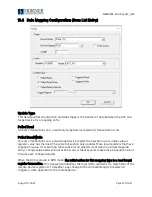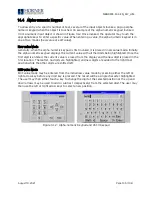
MAN0974-13.1-EN_XL7_UM
August 19, 2021
Page 143 | 198
File operations are accomplished by pressing the appropriate button at the bottom of the
removable media viewer. The configuration of the removable media object that invokes the
removable media viewer defines what buttons are enabled and available to the user. A button
is grayed and does not respond to touch if configured as disabled.
The (Enter) button (if enabled)
performs certain operations based on the selected file’s type:
..
change display to parent directory
<DIR>
change display to child directory
bmp, jpeg
display bitmap (if compatible format)
pgm
load application (if compatible model and
version)
Alternately, the (enter) button can be configured to simply load the ASCII representation of the
file path (including the file name) to a group of OCS registers. That pathname can then be used
by ladder for opening and manipulating that file.
Once view operations are complete, simply touch the
Esc
button to remove the pop-up
removable media viewer.
If the removable media is used in an application, the removable media device requires changing
by the operator, and the application is attempting to write to the removable media when it is
removed, the screen designer should create objects that allow the operator to temporally halt
access to the removable media. This prevents corruption to the file system if the removable
media is removed during a file write sequence. The graphic objects should set OCS register
%SR174.1 (when requesting the card be removed) and provide an indicator based on OCS
register %SR174.2 (which indicates that it is safe to remove the removable media).
Figure 14.9
–
Example application segment for safe removal of removable media
















































